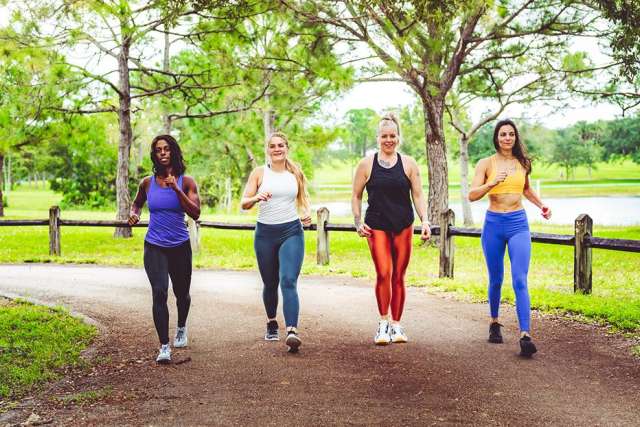Everyone knows that walking is an easy way to move your body. It can be done anywhere, any time and at any age. But not everyone counts walking as cardiovascular exercise.
Many people assume that to be truly beneficial, cardiovascular exercise needs to be done at a high intensity and possibly involve special footwear, equipment or even a trip to the gym. That’s not the case – exercise really can be as simple as taking a walk.
According to a 2013 research study, walking briskly can help your health just as much as running. When you walk regularly and at the right pace, you can get all the cardiovascular exercise you need, plus added health benefits. Here’s what you need to know:
Pick up the pace when walking for cardio
The American Heart Association (AHA) recommends 150 minutes (2.5 hours) a week of moderate-intensity aerobic (cardio) activity. Moderate-intensity exercise includes any physical activity that gets your heart, lungs and all your large muscle groups working harder. Walking meets all those criteria.
To get the most benefit from walking, exert at least a medium amount of effort. When you exercise at moderate intensity, your heart should beat faster, and you should be breathing harder than normal, but you should still be able to talk. For most people, walking briskly at 2.5 miles per hour or more qualifies as moderate intensity.
Added health benefits of walking
Walking is the most popular form of exercise in the United States, and for good reason. It offers a number of benefits for both physical and mental health.
Walking at a moderate pace for 150 minutes a week can help you achieve:
Better heart health
Walking briskly increases your heart rate, improves circulation and lowers your blood pressure. Research shows that stepping up your walking pace may cut your risk of dying from heart disease in half, when compared to people walking at a slow pace. Postmenopausal women who walk 30 minutes a day lessen their risk of stroke by 40% (for brisk walkers) and 20% (for slower walkers).
Weight management
Walking uses all the large muscle groups in your body, including your legs, abdominal muscles and arms. Since it engages so many large muscles, walking burns calories and can help you trim fat. According to the American Cancer Society’s , walking briskly burns almost 300 calories per hour for someone weighing 150 pounds.
Relief for joint pain
If you have knee, hip, ankle or other joint pain, your first inclination may be to avoid exercise. But according to the U.S. Centers for Disease Control and Prevention, walking regularly is an effective and safe way to reduce joint pain. It may relieve adult arthritis pain as effectively as over-the-counter medications.
Slowed or reduced risk of mental decline
Walking reduces your risk for health factors related to cognitive function, including heart disease, stroke and depression. As a result, it also reduces mental decline. The National Institute on Aging reports brisk walking is considered more beneficial to cognitive health than non-aerobic stretching and strength training.
Stronger bones
Walking can slow or stop the loss of bone density (mass), especially in people with osteoporosis. According to the Arthritis Foundation, research shows that postmenopausal women who walk 30 minutes a day may reduce their risk of hip fractures by 40 percent.
Ways to make your walking workout plan successful
Walking is only an effective workout plan if you do it regularly. That means staying comfortable, injury-free and motivated.
Get prepared
Taking time to prepare before walking will help you avoid injury and discomfort. The AHA recommends preparation that includes:
- Supportive footwear: Protect your back and joints with footwear designed for walking or running. Avoid 100% cotton socks, which retain moisture and can lead to blisters. Instead, try socks made with acrylic or polyester (often advertised as “dry fit”).
- Comfortable clothing: Dress in layers and choose material that wicks away sweat. It will keep you cool and keep your skin free of clogged pores.
- Stretching: Stretch your hamstrings, shoulders, calves, chest and back both before and after your workout.
- Hydration: To avoid dehydration, drink a tall glass of water before and after walking. If you’re walking for more than 30 minutes, bring water to drink along the way.
- Focusing on form: The right technique keeps bones and joints aligned properly and prevents back and neck pain. When walking, keep your head up with your chin parallel to the ground. Swing your arms and step from heel to toe.
Stay motivated
Even the best intentions get hindered by boredom and repetition. But to stay on track, there are some simple steps you can take:
- Make it interesting by walking in new locations or listening to a book or podcast while you walk.
- Partner up with a friend or group who will help keep you accountable.
- Schedule your workout and add it to your calendar so that you won’t schedule work meetings, doctor’s appointments or anything else during that time.
- Set a goal, such as walking a 5k or half-marathon to guide your walking and training.
- Walk to a destination about 15 minutes away, such as a coffee shop, a friend’s house or a grocery store and then walk back home.
Talk to your primary care provider to identify healthy fitness goals and determine the best cardiovascular exercise for you.



